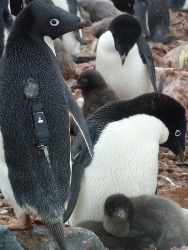Autonomous robots called gliders have been programmed to follow the routes of Adelie penguins and gather data, which would help scientists to gain insight into the reasons for the rapid fall in the population of birds swimming in the Southern Oceans of Antarctica.
The penguins have been fading off in huge numbers and according to the scientists seawater warming could be the major reason for this catastrophe. The vanishing sea ice could also be one of the reasons. Huge quantity of algae that grow on the ice attracts the krill, which in turn are eaten by the penguins.
 Penguin-tagged-11
Penguin-tagged-11
According to Bill Fraser, who is the President of the Polar Oceans Research Group and a penguin biologist, the penguins are probably dying from starvation. They normally spend hours and sometimes days on feeding trips. However, once they dive below the surface it was not possible to figure out what the birds are facing under the water. Hence oceanographers, Alex Kahl, Fraser and Oscar Schofield, who did research work at Rutgers University, decided to use robots to discover the ocean conditions when the penguins are swimming in the water. Fraser has been fastening radio tags on the penguins for 10 years to track their trail. However, the equipment, which could determine the presence of algae or krill in the water, was too huge to fix to a bird weighing 9-10 pounds.
Research ships have been combing through deep underwater canyons, where the penguins are normally found, but were able to piece through only a hazy and partial picture of the happenings in the ocean. The gliders could probably give a clearer picture and also prove to be a continuous real time information channel.
Schofield has been utilizing gliders for a number of years to collect information on ocean chemistry and physics to study about plankton ecology. In 2008, he and Fraser tamed up to find out if the gliders could be programmed to gather data on the existence or lack of krill and algae inside the underwater canyons. The gliders uncovered blooms of microscopic algae, which are eaten by the krill and this added a fillip to the scientists beliefs that penguins are feeding in these areas.
The next step for the researchers was to use near real-time penguin-location data for directing the gliders. They were able to track the penguin’s location data in the evening and designed a route for the glider for the next day. In the month of January, they fixed acoustic sensors on the gliders, which would map the places where krill was found and eaten by the penguins.
Schofield stated that his goal was to build an automated network over the next five years where the gliders could adjust the tracks automatically to find the places where penguins are foraging.